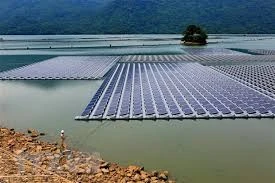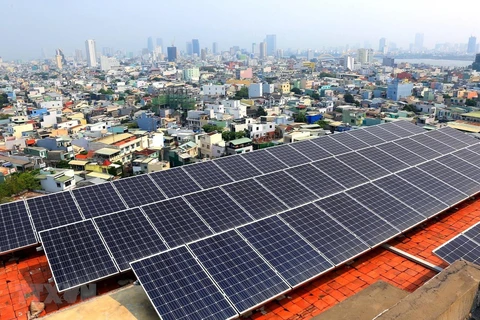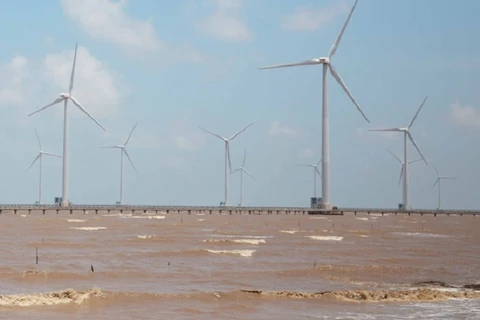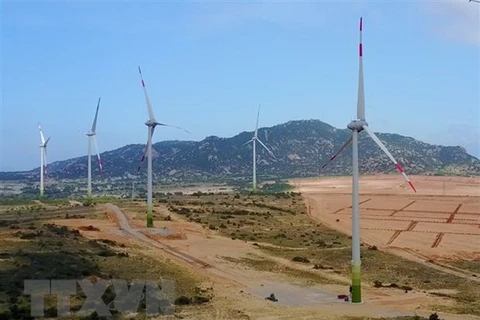To promote the development of renewable energy, there should be a prioritised policy mechanism on electricity prices and loan interest rates, according to Dr. Nguyen Manh Hien, President of the Scientific Council at the Vietnam Clean Energy Association.
 Vietnam Energy Forum 2020 held by the Industry and Trade Newspaper on June 18 in Hanoi (Photo: Duc Duy/Vietnam+)
Vietnam Energy Forum 2020 held by the Industry and Trade Newspaper on June 18 in Hanoi (Photo: Duc Duy/Vietnam+) Vietnam’s economy is developing at high speed, and a strong increase in energy demand is following it. These are huge challenges when the primary energy sources such as coal, oil and gas are gradually being exhausted.
The development of renewable energy sources, such as solar power and wind power, are one of the sustainable development directions, contributing to ensuring the demand for consumption as well as national energy security.
This is also the main discussion points at the Vietnam Energy Forum 2020 with the theme "Green energy development: Trends and Challenges," co-organised by the Industry and Trade Newspaper and the Department of Electricity and Renewable Energy on the June 18 in Hanoi.
Big energy pressures
A report by the Vietnam Electricity (EVN) shows that in the first months of 2020, amid the epidemic’s effect on production, the demand for additional loads still increased by over 7 percent, in some regions the figure even grew more than 11 percent.
The unfavourable hydrological situation has significantly affected the supply from hydropower. Specifically, in May 2020, despite heavy rains in some areas, the amount of water to the reservoirs was still low, only 30-60 percent of the average for many years, since rain occurred mainly in the lower areas of the reservoir.
Therefore, the total output of hydroelectricity in the whole system in May was 2.23 billion kWh, 0.84 billion kWh lower than the yearly target. In the first five months of the year, it was only 9.48 billion kWh, 3.26 billion kWh lower than the set yearly target.
It is expected that, in 2020, the electricity demand will still be met, but from 2021 onwards, there will be an increased danger of power shortages. The electricity shortage in the South may even increase higher and last until 2025, If the load increases, the amount of water in hydropower reservoirs will be worse than the average for many years; Block B and Ca Voi Xanh (Blue Whale) gas resource are behind schedule and new power projects continue to be behind schedule compared to current updates.
Worryingly, many power source projects under the revised power masterplan 7 are still far behind schedule, or the progress has not yet been determined. This leads to electricity shortage risks in Vietnam in the near future.
A recent report by the National Power Steering Committee shows that, out of 62 projects with a capacity of 200 MW or more in the adjusted power masterplan 7, only 15 projects are on schedule, the remaining 47 projects are behind schedule or have not determined their progress yet.
Therefore, in addition to solutions to remove difficulties for projects with slow progress and promote electricity-saving, it’s agent to promote the development of renewable energy projects such as wind power and solar power.
Hoang Tien Dung, Director of the Electricity and Renewable Energy Department (Ministry of Industry and Trade) said that "Coal has currently been imported to generate electricity. Gas is also expected to be imported and there is a higher risk of heavy reliance on imported fuel sources, while the imbalance between the regions has yet to be overcome. There is always a lack of energy in the South, and it is necessary to have a relatively high transition from North and Central to South.”
 Deputy Minister of Industry and Trade Hoang Quoc Vuong speaks at the Vietnam Energy Forum 2020 (Photo: Duc Duy/Vietnam+)
Deputy Minister of Industry and Trade Hoang Quoc Vuong speaks at the Vietnam Energy Forum 2020 (Photo: Duc Duy/Vietnam+) Untie the "knots"
If large hydroelectric power sources are fully exploited, other large power source targets also need a lot of time to be completed. So, amid the demand for additional loads increasing rapidly, renewable energy is more important in terms of ensuring power supply.
According to Assoc. Prof. Dr. Bui Quang Tuan, Director of the Vietnam Economic Institute, in recent years, along with the 4th industrial revolution, the next trend is green growth. Accordingly, renewable energy sources make up the majority and replace electricity using fossil fuels.
He continued to state that with the growth strategy shifting from scale to quality, Vietnam needs to concretise many policies, creating a foundation for this sector to develop, especially to attract investment from FDI enterprises.
“This is a career that needs the joining hands of many entities, from managers, local authorities, businesses to households. If there is an attractive electricity price mechanism, households will participate to invest and sell electricity to the country,” said Assoc. Prof. Dr. Bui Quang Tuan.
Report of the Ministry of Industry and Trade shows that the demand for primary energy in the past 10 years (from 2007-2017) grew 14.6 percent, with the average growth of electricity and food production by 9.5 percent. It is forecasted that in the next five years, electricity demand will still grow by 8.5-9.5 percent.
In fact, with a series of policies from the authorities, the development of solar power in Vietnam has made a strong breakthrough.
At present, solar power has a capacity of more than 5,000 MW and nearly 1,000 MW of wind power. It is expected that, in the next one-two years, thousands of MW of wind power will continue to be put into operation, supplementing the national grid.
However, there will be greater challenges as renewable energy continues to develop. More specifically, according to Dr. Nguyen Manh Hien, Chairman of the Science Council, Vietnam Clean Energy Association, to promote the development of renewable energy, there should be a prioritised policy mechanism for electricity prices and loan interest rates for power projects using biomass resources because of their low investment cost and high capacity.
Deputy Minister of Industry and Trade Hoang Quoc Vuong also said that the nature of clean energy is a form of energy with no stability, and is harder to operate than traditional energy. This poses a challenge in how to develop quickly while ensuring the safety and reliability of the electrical system.
With great potential to encourage investment in clean energy, the Politburo has issued Resolution 55 on the orientation of the National Energy Development Strategy of Vietnam from 2030, with a vision to 2045.
Mr. Vuong said that the Ministry of Industry and Trade is directing relevant agencies to implement Resolution 55 through the electricity sector development plan.
"The Ministry of Industry and Trade is directing the formulation of the national electricity development plan and it is expected that in October 2020, it will be completed and submitted to the Government for consideration and approval, creating a basis for ensuring energy security," Vuong noted./.

























